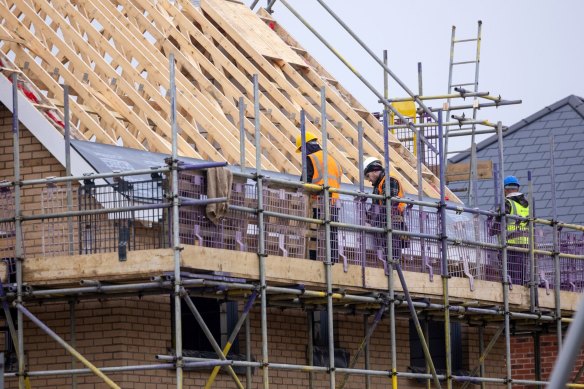Editorial
Exposing councils with slow DA approval histories will spur reform
The glacial pace with which some municipalities process development applications has long hindered housing development in NSW and the Labor government’s new name and shame league table should go some way towards prodding the slowpokes into faster action.

The NSW government has a target of 377,000 extra homes within five years.Credit: Bloomberg
The league table, published for the first time this week, revealed the top and bottom performers, with Georges River, North Sydney and Sutherland the slowest councils in Greater Sydney in terms of DA approvals. The fastest were Wollondilly and Blacktown, with an average of 53 and 65 assessment days, respectively. In comparison, Georges River took 259 days, North Sydney 246 and Sutherland 323. Overall, the league table showed 21 councils in Sydney take more than an average 115 days to approve DAs.
With local councils assessing 85 per cent of residential DAs in NSW, the league table is part of government strategy to ensure it meets its ambitious target of 377,000 extra homes within five years by pushing for faster assessments. Aside from the league table exposing their performance records, councils are being offered incentives of $200 million to meet the new government’s expectations for DAs, planning proposals and strategic planning. These financial incentives include grants for councils to fund more green space, such as parks and sporting facilities, as well as the maintenance of local streets and footpaths. The time taken for regionally significant development applications to be referred to planning panels will be published from next month.
Councils that consistently fail to cut their DA processing times will also be subject to performance improvement orders and if they continue to underachieve, they could see the Minister for Local Government Ron Hoenig appoint a planning administrator, or hand functions to a Sydney or regional planning panel.
Not unexpectedly, councils named in the league table as the slowest at processing DAs, pushed back. Some disputed the government figures, others blamed technical hitches, staff shortages and old DAs left mouldering in the system. In other words, the same old excuses.
But the league table was broadly welcomed by housing advocates. Housing Now chair David Borger welcomed the transparency. “Tools that allow constituents to see how their council is tracking in terms of addressing the housing crisis will send a shiver down the spine of NIMBY representatives,” he said.
We wonder if there is more in store. With council elections in September, Labor may have kept a chunk of potential reform to councils up their sleeves to deploy after the elections, rather than before given recalcitrant councils and candidates standing on strong localism platforms would undoubtedly use further change to bash the government and cement NIMBYism.
The Herald welcomes Labor’s move to apply pressure on councils on housing. But given the urgency of the crisis and the pivotal role played by councils, we believe the government has not gone far enough in what it can do to override powers or provide incentives to councils to improve the way they approve and create the housing so desperately needed in Sydney.
Get a weekly wrap of views that will challenge, champion and inform your own. Sign up for our Opinion newsletter.